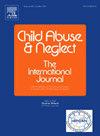Psychological intimate partner violence, child witnessing of parental arguments, and emotional-behavioral outcomes in five-years old: The French ELFE cohort
IF 3.4
2区 心理学
Q1 FAMILY STUDIES
引用次数: 0
Abstract
Background
Intimate partner violence (IPV) is associated with children's emotional and behavioral difficulties. Psychological-IPV (P-IPV) is most common, and occurs alone or along other forms of IPV. Little is known about the longitudinal course of P-IPV exposure and its consequences on children taking into account whether or not they are present during parental arguments.
Objective
To identify longitudinal trajectories of P-IPV from preconception through the child's second year of life and examine associations with children's emotional-behavioral outcomes at age five years, depending on the child's presence during parental arguments in the second year of life.
Participants and setting
Data from the nationally representative French birth cohort ELFE including children born in 2011 were used.
Methods
P-IPV exposure was assessed before conception, during pregnancy, at two months and at two years postpartum. Parents completed the Strengths and Difficulties Questionnaire (SDQ) at five years. Group-based trajectory modelling was used to identify P-IPV trajectories. Multivariate logistic regression models were used to study the relationship between P-IPV trajectories and SDQ.
Results
9639 children were included. Five trajectories of exposure to P-IPV were identified: minimal (70.6 %), prenatal (10.0 %), increasing (6.4 %), decreasing (7.5 %), persistent (5.5 %). Persistent and decreasing P-IPV trajectories and frequent child presence during parental arguments were associated with children's increased odds of having abnormal total SDQ scores (OR 2.31 95 % CI 1.54–3.47; OR 1.64 95%CI: 1.11–2.43; OR 1.88 95%CI:1.17–3.02, respectively).
Conclusions
Early identification and consideration of children living in a home where IPV occurs could allow provision of timely and appropriate support.
心理亲密伴侣暴力、儿童目击父母争吵和五岁儿童的情绪行为结果:法国ELFE队列。
背景:亲密伴侣暴力(IPV)与儿童的情感和行为困难有关。心理IPV (P-IPV)是最常见的,可以单独发生或与其他形式的IPV一起发生。关于P-IPV暴露的纵向过程及其对儿童的影响知之甚少,考虑到父母争吵时他们是否在场。目的:确定P-IPV从孕前到儿童两岁的纵向轨迹,并研究儿童在五岁时情绪行为结果的关系,这取决于儿童在两岁时父母争吵的存在。参与者和环境:数据来自具有全国代表性的法国出生队列ELFE,包括2011年出生的儿童。方法:在受孕前、怀孕期间、产后2个月和2年评估P-IPV暴露情况。家长在五岁时完成了优势和困难问卷(SDQ)。采用基于群的轨迹模型识别P-IPV轨迹。采用多元逻辑回归模型研究P-IPV轨迹与SDQ之间的关系。结果:共纳入9639名儿童。确定了五种P-IPV暴露轨迹:最小(70.6%),产前(10.0%),增加(6.4%),减少(7.5%),持续(5.5%)。持续和减少的P-IPV轨迹以及父母争吵期间儿童频繁出现与儿童总SDQ得分异常的几率增加相关(OR 2.31 95% CI 1.54-3.47;95%ci: 1.11-2.43;OR 1.88 95%CI分别为1.17-3.02)。结论:早期识别和考虑家庭中发生IPV的儿童可以提供及时和适当的支持。
本文章由计算机程序翻译,如有差异,请以英文原文为准。
求助全文
约1分钟内获得全文
求助全文
来源期刊

Child Abuse & Neglect
Multiple-
CiteScore
7.40
自引率
10.40%
发文量
397
期刊介绍:
Official Publication of the International Society for Prevention of Child Abuse and Neglect. Child Abuse & Neglect The International Journal, provides an international, multidisciplinary forum on all aspects of child abuse and neglect, with special emphasis on prevention and treatment; the scope extends further to all those aspects of life which either favor or hinder child development. While contributions will primarily be from the fields of psychology, psychiatry, social work, medicine, nursing, law enforcement, legislature, education, and anthropology, the Journal encourages the concerned lay individual and child-oriented advocate organizations to contribute.
 求助内容:
求助内容: 应助结果提醒方式:
应助结果提醒方式:


